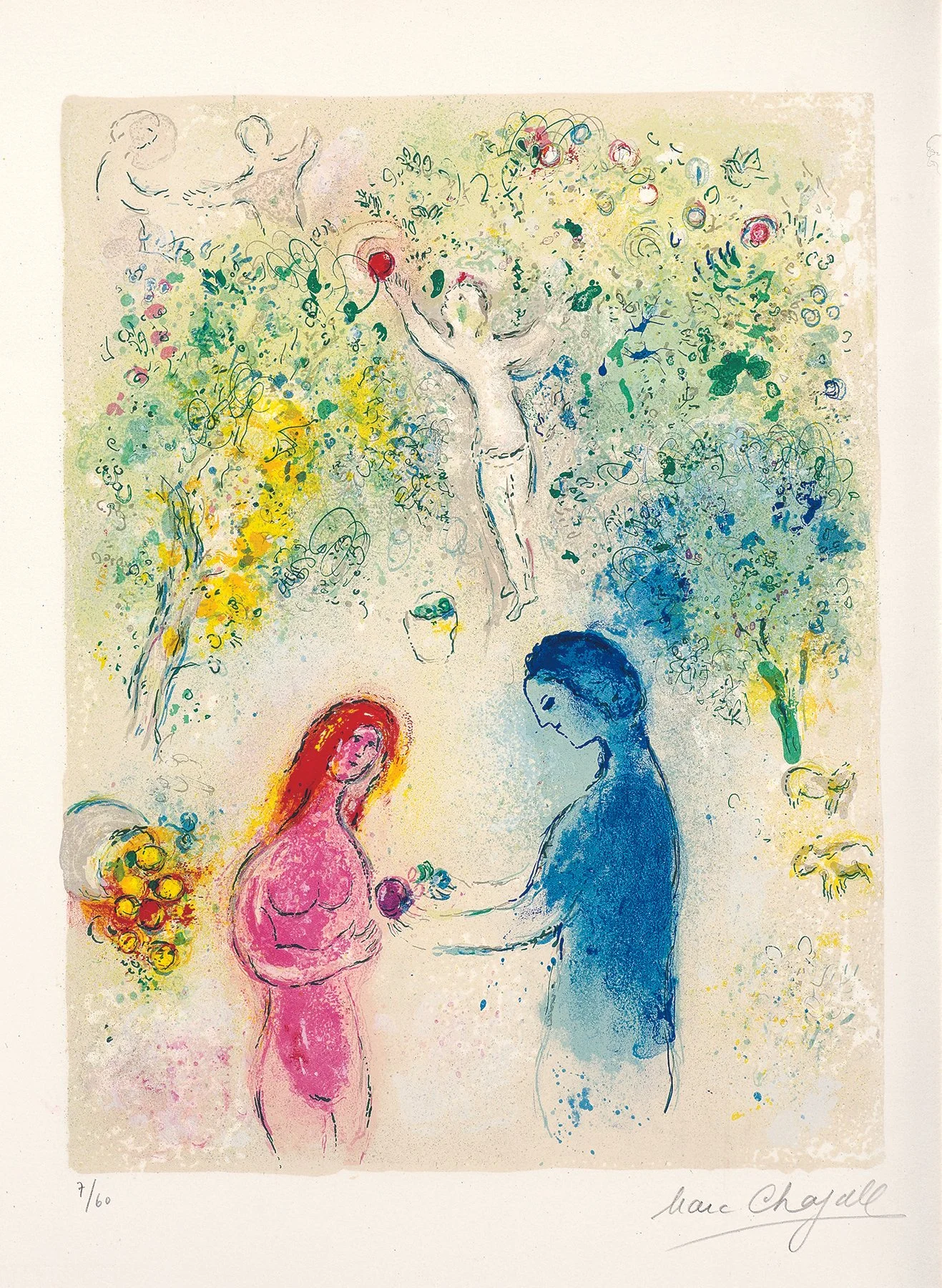Upcoming Exhibitions
Earamichia Brown, Force of Nature, 2024. Cotton textiles, batting, and a combination of cotton and polyester threads; trapunto, hand quilting, machine quilting, digital printing. Courtesy of the artist and SAQA.
AI: Artistic Interpretations, Studio Art Quilt Associates
on view February 5–May 10, 2026
This exhibition delves into the imaginative possibilities that arise when artists embrace the data-driven era, using artificial intelligence (AI) as a catalyst for innovation in fiber art.
This exhibition is curated by LSUMOA Chief Curator, Michelle Schulte, LSU Professor Golden Richard (Computer Science and Engineering), and LSU Associate Professor Brendan Harmon (Landscape Architecture) and managed by Studio Art Quilt Associates. It will travel to museums across the country for two additional years.
Marc Chagall, Daphnis and Chloe – Frontispiece, 1961. Color lithograph on Arches wove paper. Collection of the Park West Museum.
Daphnis and Chloe and Other Lovers: Lithographs by Marc Chagall
on view February 12–May 24, 2026
Experience Marc Chagall’s lyrical world of myth, memory, and color through fifty luminous lithographs illustrating the ancient Greek love story Daphnis and Chloe. Created between 1952 and 1961, the series showcases Chagall’s mastery as a printmaker and his lifelong exploration of love as both inspiration and artistic theme. Drawing from travels in Greece, personal history, and the Mediterranean landscape, Chagall brings the tale of two young lovers to life with dreamlike imagery and vibrant hues.
This exhibition is organized by Carole Sorell, Inc., curated by David S. Rubin, and presented by the Park West Foundation. It is supported by a grant from the Pennington Family Foundation.
Edgar Cano, Life is Beautiful, 2022. Oil on linen. Photograph by Anna Poe
South Arts Southern Prize & State Fellowships for Visual Arts
on view June 4–September 6, 2026
Since its launch in 2017, the South Arts Southern Prize & State Fellowships for Visual Arts has celebrated and supported the most compelling contemporary artists in the American South. The 2025 touring exhibition organized by South Arts, a nonprofit organization that supports, promotes, and celebrates Southern art and artists, features nine State Fellows—Loretta Pettway Bennett (Alabama), Gonzalo Fuenmayor (Florida), Masela Nkolo (Georgia), Travis Townsend (Kentucky), Edgar Cano (Louisiana), Stephen Phillips (Mississippi), Lydia C. Thompson (North Carolina), Felicia Greenlee (South Carolina), and Tabitha Arnold (Tennessee).
The show presents a striking synthesis of past and present, weaving ancestral craft and traditional techniques with current vision and ideology. Through ceramics, textiles, painting, drawing, and sculpture, the artists explore heritage, thought, and identity in varying forms, from quilting and African mask-making to apocalyptic Biblical imagery, presenting their ideas within a contemporary framework. Each work reflects a mastery of materials, whether in the luminous sheen of a ceramic glaze, the expressive tension of charcoal, or the layered intricacy of woven fiber.
The 2025 South Arts Southern Prize & State Fellowships for Visual Arts exhibition is generously supported by the Maxwell/Hanrahan Foundation, the Windgate Foundation, Southern First Bank, The Warner Fund, and the Hambidge Center.
Anne Noggle, Stellar by Starlight #2, 1986. Silver Gelatin print on paper.
ReVision: Women in Photography
on view June 11–August 30, 2026
This summer, the LSU Museum of Art partners with the Paul R. Jones Collection at the University of Alabama to present ReVision: Women in Photography. The exhibit showcases images that explore themes such as social justice, aging, feminism, relationships, and feminine aesthetics, all from the viewpoint of women representing a variety of backgrounds, heritages, and experiences. Through intimate portraits, conceptual narratives, and documentary approaches, the artists challenge assumptions about gender, identity, and representation while offering new perspectives on the evolving roles of women in art and society. Together, their work highlights the intersections of personal and collective histories, revealing how photography can serve as both a tool of empowerment and a means of re-imagining shared or personal narratives.
The images drawn from the LSUMOA’s collection have never been displayed before, with many donated over the last ten years. Photographers include Sheila Turner, Carrie Mae Weems, Celestia Morgan, Clarissa Thompson Sligh, Sheila Pree Bright, Amalia Amaki, Suda House, Marina Mullaney, Anne Noggle, Kristine Thompson, Kenda North, Akasha Rabut, and Melanie Walker.




